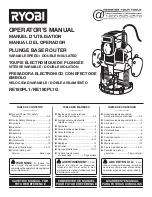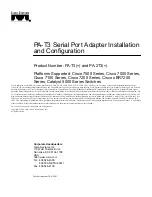
Vigor3100 Series User’s Guide
39
I
I
n
n
s
s
t
t
a
a
n
n
t
t
M
M
e
e
s
s
s
s
e
e
n
n
g
g
e
e
r
r
(
(
I
I
M
M
)
)
a
a
n
n
d
d
P
P
e
e
e
e
r
r
-
-
t
t
o
o
-
-
P
P
e
e
e
e
r
r
(
(
P
P
2
2
P
P
)
)
A
A
p
p
p
p
l
l
i
i
c
c
a
a
t
t
i
i
o
o
n
n
B
B
l
l
o
o
c
c
k
k
i
i
n
n
g
g
As the popularity of all kinds of instant messenger application arises, communication cannot
become much easier. Nevertheless, while some industry may leverage this as a great tool to
connect with their customers, some industry may take reserve attitude in order to reduce
employee misusage during office hour or prevent unknown security leak. It is similar situation
for corporation towards peer-to-peer applications since file-sharing can be convenient but
insecure at the same time. To address these needs, we provide IM and P2P blocking
functionality.
D
D
e
e
n
n
i
i
a
a
l
l
o
o
f
f
S
S
e
e
r
r
v
v
i
i
c
c
e
e
(
(
D
D
o
o
S
S
)
)
D
D
e
e
f
f
e
e
n
n
s
s
e
e
The
DoS Defense
functionality helps you to detect and mitigate the DoS attack. The attacks
are usually categorized into two types, the flooding-type attacks and the vulnerability attacks.
The flooding-type attacks will attempt to exhaust all your system's resource while the
vulnerability attacks will try to paralyze the system by offending the vulnerabilities of the
protocol or operation system.
The
DoS Defense
function enables the Vigor router to inspect every incoming packet based on
the attack signature database. Any malicious packet that might duplicate itself to paralyze the
host in the secure LAN will be strictly blocked and a Syslog message will be sent as warning, if
you set up Syslog server.
Also the Vigor router monitors the traffic. Any abnormal traffic flow violating the pre-defined
parameter, such as the number of thresholds, is identified as an attack and the Vigor router will
activate its defense mechanism to mitigate in a real-time manner.
The below shows the attack types that DoS/DDoS defense function can detect:
1. SYN flood attack
2. UDP flood attack
3. ICMP flood attack
4. TCP Flag scan
5. Trace route
6. IP options
7. Unknown protocol
8. Land attack
9. Smurf attack
10. SYN fragment
11. ICMP fragment
12. Tear drop attack
13. Fraggle attack
14. Ping of Death attack
15. TCP/UDP port scan
C
C
o
o
n
n
t
t
e
e
n
n
t
t
F
F
i
i
l
l
t
t
e
e
r
r
i
i
n
n
g
g
To provide an appropriate cyberspace to users, Vigor router equips with
URL Content Filter
not only to limit illegal traffic from/to the inappropriate web sites but also prohibit other web
feature where malicious code may conceal.
Once a user type in or click on an URL with objectionable keywords, URL keyword blocking
facility will decline the HTTP request to that web page thus can limit user’s access to the
website. You may imagine
URL Content Filter
as a well-trained convenience-store clerk who
won’t sell adult magazines to teenagers. At office,
URL Content Filter
can also provide a
job-related only environment hence to increase the employee work efficiency. How can URL
Content Filter work better than traditional firewall in the field of filtering? Because it checks
the URL strings or some of HTTP data hiding in the payload of TCP packets while legacy
firewall inspects packets based on the fields of TCP/IP headers only.
On the other hand, Vigor router can prevent user from accidentally downloading malicious
codes from web pages. It’s very common that malicious codes conceal in the executable objects,
such as ActiveX, Java Applet, compressed files, and other executable files. Once downloading
these types of files from websites, you may risk bringing threat to your system. For example, an
Содержание Vigor 3100 Series
Страница 2: ...Vigor3100 Series User s Guide ii...
Страница 6: ......
Страница 20: ...Vigor3100 Series User s Guide 14...
Страница 114: ...Vigor3100 Series User s Guide 108...
Страница 122: ...Vigor3100 Series User s Guide 116...
















































